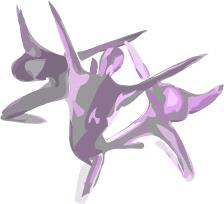What is cellulite?
Cellulite
is a series of ripples of fat cells and subcutaneous connective tissue under the skin. Usually found on the thighs and butt,
especially in women, it has a characteristic 'orange peel' appearance. It affects women but very few men, probably because
of a difference in cell structure between men and women.
One plausible
explanation - which also explains why very few men suffer from cellulite - is based on the composition and behavior of women's
fat cells and the connective tissue that holds them in place. Very simply, a woman's connective tissue is very inflexible,
so as she gains weight and her fat cells expand, they tend to bulge upwards towards the surface of the skin, giving the classic
orange-peel appearance of cellulite. In men, not only is there generally less fat on the thighs, but also the outer skin is
thicker and thus obscures what is happening to any surplus fat below.
Current science on cellulite:
Until
recently, the catch phrase of the unaffected by cellulite was "it's a fat problem just lose weight". But we know that's not the whole story. Super skinny girls get cellulite, as do babies on their bottoms.
Almost every one of us (an estimated 94 per cent of adult women) can vouch for the fact that as we get older, get pregnant,
whether we work out or not, those dimples, ripples and strange-looking lumps of fat start appearing. But what can we do about
it? Plenty. Today's take on cellulite is that it's a multi-factorial problem requiring a multi-factorial strategy. Bad circulation,
female hormones fat, toxins, and damaged skin, it's best treated through exercise, nutrition and skincare technology. In fact,
this holistic approach is now mainstream that medics stand shoulder to shoulder with nutritionists, cosmetic scientists.
Non-exercise methods to help reduce or prevent cellulite forming:
- Avoid processed and refined foods which contain excess salt, sugar or fat.
- Eat plenty of fibre - Follow a diet rich in fresh fruit and vegetables, whole grains, beans
and legumes. These high fibre foods help eliminate waste and toxins.
- Reduce your intake of coffee, tea, sugar, salt and alcohol, all of which create a build
up of toxins in the body.
- Maintain a normal weight. If you are overweight reduce your weight gradually.
- Quit smoking.
- Avoid unnecessary medication, like diet-pills, pep-pills, sleeping pills, laxatives and
diuretics.
- Drink plenty of water and eat regular daily helpings of fresh fruit.
- Try rubbing a good quality Aloe Vera cream into the cellulite-affected areas
- Avoid all expensive so-called 'cures' for cellulite. Contrary to popular opinion, there
are no magical creams or pills that will get rid of cellulite. The Federal Trade
Commission (FTC) has prosecuted several companies for false advertising of cellulite products.
- Cellulite is not simply a fat issue," says nutritionist Anthony Haynes. "Really, it is
a reflection or your body's inability to process hormones and toxins effectively through the liver and kidneys. The resulting
imbalance leads to toxins (from the environment, additives in food, caffeine etc) being stored in the body fat and, because
women's skin is thinner than men's, the fat cells bulge out and dimple visibly. My advice for an eating plan is simple.
Exercise and Cellulite:
Exercise
helps to reduce cellulite because it helps to boost circulation and restore a slim subcutaneous fat layer. Aerobic exercise
that raises your heart rate is the best type of anti-cellulite exercise. Like any other fat or fat cells, cellulite fat responds
to calorie-restriction and is burned off by calorie-deficit, but it is the stored fat that goes away - the fat cell is still
present and can refill if calorie excess resumes. That is why many treatments of cellulite are directed at the surgical removal
of the fat cells themselves.
Personal
trainer Matt Roberts says that the, only type of exercise that effectively reduces cellulite is calorie-burning exercise that
gets you hot and sweaty. "The higher your activity level and heart rate, the more easily your stubborn fat cells are utilised,"
he says. "Running, speed walking, swimming, cycling or aerobics are the best. I love yoga and Pilates, but they won't do anything
for cellulite. “
Exercise
that uses the upper and lower body (rowing, cross-country skiing and running) uses large movements that promote a high blood
flow and break down fat cells. If you use weights, try using peripheral heart action training (PHA). This involves alternating
your exercises between the upper and lower body. Overall, it's best to vary your exercise. Constant challenges mean constant
adaptation for the body. When the body is adapting, its calorie demands are higher and its use of all fat stores is increased.
Take Away:
Yes,
BFL will help (because it’s reducing over all body fat and amount of toxins that are being taken in by the body while
you are eating for life); however BFL can not guarantee a full disappearance of all cellulite on your body.
NOTE:
There are a LOT
of people who would like to make a buck by selling you a product that may or may NOT work, so PLEASE be careful and do your
research before you pay for anything.
Best Spot I found for more reading:
http://cellulite.articleinsider.com/11159_cellulite_treatment_tips.html
References:
http://www.annecollins.com/cellulite/diet.htm
http://www.mydietbuddy.com/exercise-for-cellulite.htm
http://www.e-face.co.uk/articles/cellulite_vogue.htm
http://cellulite.articleinsider.com/11159_cellulite_treatment_tips.html

